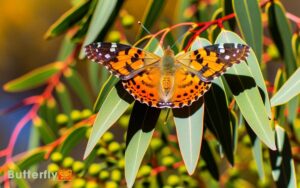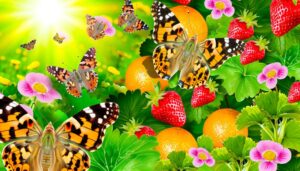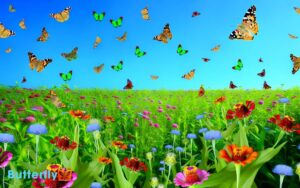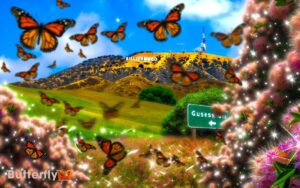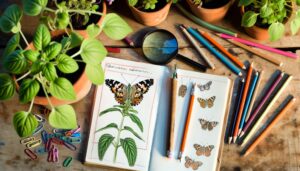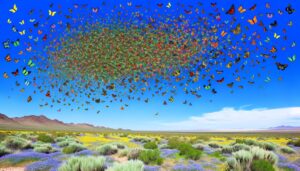Painted Lady Butterfly Coloring Page: Fun and Creative!
The Painted Lady Butterfly (Vanessa cardui) showcases arresting orange-brown wings intertwined with black and white spots, ideal for both detailed coloring activities and taxonomic study.
Belonging to the Nymphalidae family, it spans 5 to 9 centimeters. Using high-quality colored pencils and a fine-tipped black marker can enhance accuracy.
Focus on the forewings and hindwings, employing shading for depth. Coloring these butterflies not only cultivates fine motor skills but also enriches educational understanding, making the experience both artistic and scientific.
For those interested in more intricate coloring methods and biological insights, there’s much more to discover ahead.
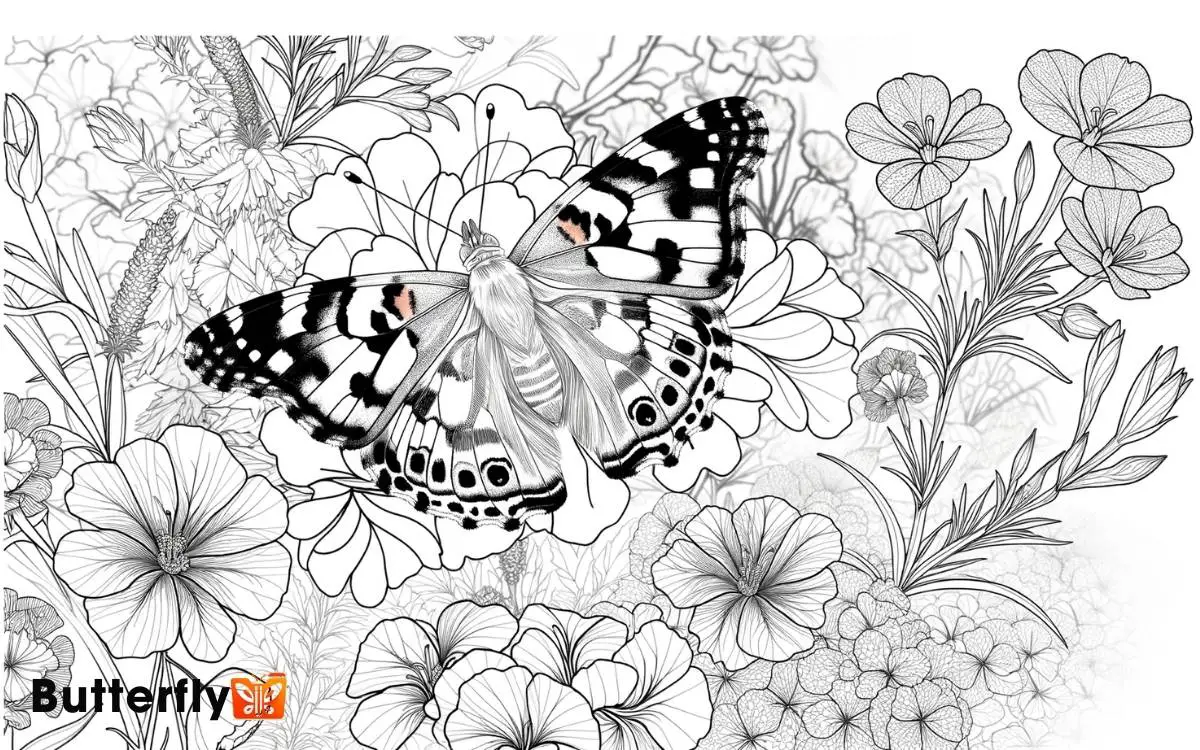
Key Takeaways
Understanding Painted Lady Butterflies
The Painted Lady Butterfly (Vanessa cardui) is a globally distributed species known for its striking appearance and remarkable migratory behavior.
This lepidopteran is identifiable by its orange-brown wings adorned with black and white spots, a characteristic pattern aiding in camouflage and predator deterrence. Vanessa cardui belongs to the Nymphalidae family, exhibiting a wingspan ranging from 5 to 9 centimeters.
These butterflies undertake extensive migrations, sometimes spanning continents, which is a rare phenomenon among butterfly species. Their larvae, commonly known as caterpillars, primarily feed on thistles and other members of the Asteraceae family.
Observations indicate that the Painted Lady’s adaptability to various climates and habitats plays a significant role in its widespread presence across different continents.
Benefits of Coloring Activities
Coloring activities, including those involving Vanessa cardui (Painted Lady Butterfly), promote fine motor skill development through repetitive, precise hand movements.
Engaging in such activities also correlates with enhanced mental health, as coloring induces a meditative state that reduces stress and anxiety.
Detailed observations indicate that these benefits are particularly pronounced in both pediatric and geriatric populations.
Enhances Motor Skills
Engaging in coloring activities, such as filling in a Painted Lady butterfly coloring page, greatly refines fine motor skills by requiring precise hand movements and coordination.
The Vanessa cardui, commonly known as the Painted Lady, presents intricate wing patterns that necessitate meticulous coloring. This activity demands the controlled use of small muscles in the hands and fingers, fostering advanced dexterity and strength.
Observational data indicate that such tasks improve bilateral coordination, essential for tasks like writing or buttoning. The repetitive motion of coloring also enhances hand-eye coordination, important for daily activities.
Additionally, the graded control required to color within lines aids in developing consistency and precision in motor skills, beneficial for both children and adults.
Boosts Mental Health
Participating in coloring activities, such as completing a Painted Lady butterfly coloring page, has been observed to significantly reduce stress and anxiety levels, providing a therapeutic effect on mental health.
Engaging in such tasks can activate the parasympathetic nervous system, leading to a state of relaxation. Detailed observations indicate that focusing on intricate patterns can enhance mindfulness, akin to meditative practices.
The taxonomic reference of Vanessa cardui, commonly known as the Painted Lady, adds an educational element, further enriching the mental health benefits.
| Benefit | Mechanism | Outcome |
|---|---|---|
| Stress Reduction | Activates parasympathetic system | Induces relaxation |
| Anxiety Alleviation | Enhances mindfulness | Lowers anxiety levels |
| Educational Enrichment | Engages cognitive function | Stimulates learning |
Such activities combine mental relaxation and cognitive stimulation, making them highly beneficial.
Supplies You’ll Need
To accurately color a Painted Lady butterfly (Vanessa cardui), one needs high-quality colored pencils, a fine-tipped black marker, and reference images for anatomical precision.
High-quality colored pencils guarantee rich pigmentation, essential for replicating the vibrant hues of V. cardui’s wings.
A fine-tipped black marker assists in delineating the intricate venation and distinctive eyespots characteristic of this species.
Reference images provide essential insight into the butterfly’s morphology, guiding color placement and shading. Observing the dorsal and ventral wing patterns is vital; the dorsal side exhibits orange and black markings, while the ventral side features subtler, earth-toned hues.
These supplies enhance the accuracy and biological fidelity of one’s artistic interpretation of this Lepidoptera specimen.
Choosing the Right Coloring Page
Selecting an appropriate coloring page is crucial, as it should accurately depict the anatomical details of Vanessa cardui to facilitate precise and scientifically accurate coloring.
The chosen page must illustrate the butterfly’s forewings and hindwings, highlighting the orange and black patterns typical of the Nymphalidae family.
Key features such as the distinctive white spots on the forewings and the eyespots on the hindwings must be present. This guarantees that users can replicate the phenotypic traits accurately.
Additionally, the antennae, proboscis, and segmentation of the thorax and abdomen should be clearly outlined. Accurate depiction aids in understanding the morphological characteristics of Vanessa cardui, promoting educational value while engaging in the coloring activity.
A detailed, anatomically correct page enhances both learning and enjoyment.
Basic Coloring Techniques
Once the ideal coloring page is selected, mastering basic coloring techniques guarantees that the anatomical accuracy of Vanessa cardui is vividly brought to life.
It’s important to focus on areas like the forewings and hindwings, which exhibit a unique pattern of orange, black, and white markings. Users should employ smooth, even strokes to replicate the scale-like texture of the wings, mimicking the Lepidoptera’s natural appearance.
Attention to the cephalothorax and abdomen is also essential, where subtle shading can enhance the three-dimensionality of these regions.
Utilizing a fine-tipped instrument for intricate details ensures precision in the depiction of the butterfly’s compound eyes and antennae.
Such meticulous techniques foster a realistic representation of the Painted Lady Butterfly’s vivid coloration and structural intricacies. Artists and quilters alike draw inspiration from these lifelike details, carefully replicating each pattern and hue with precision. The painted ladies butterfly quilt embodies this dedication, weaving together fabric and thread to mirror the delicate beauty of nature. Through skillful craftsmanship, the quilt becomes a vibrant tribute to the butterfly’s elegance and complexity.
Advanced Coloring Tips
Incorporating advanced coloring tips requires a thorough understanding of the Painted Lady Butterfly’s (Vanessa cardui) pigmentation patterns and structural nuances. Enthusiasts must focus on the butterfly’s intricate coloration and morphology to achieve realistic depictions.
- Wing Venation: Accurately color the intricate venation patterns on both dorsal and ventral wings, reflecting their natural hues.
- Pigment Variation: Utilize subtle gradients to capture the butterfly’s diverse pigmentation, especially the orange, black, and white spots.
- Structural Texture: Highlight the wing scales’ texture by employing fine, meticulous strokes that mimic their natural arrangement.
- Light and Shadow: Apply chiaroscuro techniques to replicate the natural interplay of light and shadow, enhancing the three-dimensional aspect of the wings.
These techniques demand precision and a thorough understanding of Vanessa cardui’s physical characteristics.
Exploring Color Schemes
Examining the natural color patterns of Vanessa cardui, one can observe the distinctive orange and black markings with white spots on the forewings.
For those seeking creative color variations, they can experiment with non-traditional palettes while maintaining the characteristic wing venation.
This approach allows for both scientific accuracy and artistic expression.
Natural Color Patterns
The Painted Lady butterfly (Vanessa cardui) exhibits intricate natural color patterns that serve both as camouflage and signaling mechanisms within its habitat. These patterns aren’t merely decorative but play critical roles in the butterfly’s survival and mating behaviors.
Key aspects of the Painted Lady butterfly’s natural color patterns include:
- Dorsal Wing Surfaces: Display a complex mosaic of orange, black, and white spots aiding in predator avoidance.
- Ventral Wing Surfaces: Show muted browns and grays, providing excellent camouflage when wings are closed.
- Eyespots: Located on the hindwings, these circular markings can startle or confuse predators.
- Seasonal Variations: Color intensity and pattern complexity can vary with environmental conditions, influencing thermoregulation and predator deterrence.
Understanding these patterns offers insight into the evolutionary adaptations of Vanessa cardui.
Creative Color Variations
Artists and enthusiasts can explore creative color variations by experimenting with alternate hues and patterns that deviate from the natural palette of Vanessa cardui, allowing for unique and imaginative interpretations of this butterfly species.
By employing non-traditional colors, such as blues, purples, and metallics, one can observe how these variations impact the perception of this lepidopteran.
Color theory, including complementary and analogous schemes, can provide a scientific basis for these explorations.
| Color Scheme | Description |
|---|---|
| Complementary | Using colors opposite on the color wheel (e.g., blue and orange) |
| Analogous | Utilizing colors next to each other on the color wheel (e.g., red, orange, yellow) |
| Monochromatic | Applying different shades and tints of a single color (e.g., various blues) |
Such practices not only enhance artistic skills but also deepen the understanding of butterfly morphology.
Incorporating Nature Elements
Incorporating botanical details such as host plants and nectar sources, the coloring page enhances educational value by illustrating the ecological interactions of Vanessa cardui. This approach enriches understanding by showcasing the butterfly’s lifecycle dependencies.
Key elements include:
- Host Plants: Larvae feed on plants like thistles (Cirsium spp.), mallows (Malva spp.), and hollyhocks (Alcea spp.).
- Nectar Sources: Adults prefer flowers such as asters (Aster spp.), zinnias (Zinnia spp.), and marigolds (Tagetes spp.).
- Habitat Elements: Depictions of open fields, gardens, and meadows where Vanessa cardui thrives.
- Seasonal Variations: Illustrating migratory patterns and seasonal changes in flora.
This detailed botanical integration fosters a thorough understanding of Vanessa cardui‘s ecological role and habitat requirements.
Fun Facts About Painted Lady Butterflies
Painted Lady butterflies, known scientifically as *Vanessa cardui*, undergo remarkable metamorphic changes, moving thousands of miles across continents.
These Lepidoptera are renowned for their vast distribution, inhabiting every continent except Antarctica. Their wings display a striking pattern of orange, black, and white, aiding in predator deterrence through mimicry and camouflage.
*Vanessa cardui* experiences a complete metamorphosis, evolving from egg to larva (caterpillar), then pupa (chrysalis), and finally to adult butterfly. They feed on a diverse range of host plants, including thistles and nettles, which helps in widespread colonization.
Remarkably, their migrations are multigenerational, with successive generations continuing the journey. This species’ adaptability to various climates and habitats underscores its evolutionary success.
Using the Coloring Page in Education
Educators can leverage the Painted Lady butterfly coloring page as an engaging tool to teach students about the intricate life cycle and migratory patterns of Vanessa cardui.
By utilizing this resource, students can:
- Identify Stages: Recognize the distinct phases of the butterfly’s life cycle, from egg, larva, pupa, to adult.
- Understand Migration: Learn about the extensive migratory routes spanning continents, emphasizing the species’ unique adaptability.
- Explore Morphology: Examine the anatomical features and wing patterns that differentiate *Vanessa cardui* from other Lepidoptera.
- Foster Conservation Awareness: Discuss the ecological significance and the role of Painted Lady butterflies in pollination and biodiversity.
This educational approach not only enhances biological literacy but also fosters a deeper appreciation for entomology and conservation efforts.
Sharing Your Artwork
Sharing your completed Vanessa cardui coloring page can stimulate communal learning and provide a visual aid for discussing the morphological and ecological traits of this migratory butterfly species.
By showcasing detailed artwork, enthusiasts can highlight the distinct wing patterns and coloration that characterize Vanessa cardui, aiding in identification and taxonomy studies.
Observers can engage in discussions about the butterfly’s life cycle stages, habitat preferences, and migratory behavior, fostering a deeper appreciation for Lepidoptera biodiversity.
Additionally, sharing artwork in educational settings can support lessons on pollination, mimicry, and environmental adaptation, enhancing comprehension through visual representation.
This collaborative approach not only reinforces scientific concepts but also encourages collective enthusiasm for entomological studies and conservation efforts.
Digital Coloring Options
How can digital tools transform the process of coloring *Vanessa cardui* illustrations, providing precision and flexibility for entomological study and artistic expression?
Digital platforms offer a meticulous approach to detailing the wing patterns and hues of the Painted Lady butterfly.
Researchers and artists can benefit from:
- Layering Techniques: Allows for separate handling of anatomical features, enhancing accuracy.
- Color Matching: Guarantees precise replication of the butterfly’s natural palette, aiding in scientific documentation.
- Scalability: Adjusts the size of illustrations without loss of detail, useful for presentations and publications.
- Revision Capabilities: Facilitates easy modifications, promoting iterative refinement of the artwork.
These tools collectively support a detailed and flexible approach to documenting and appreciating the intricate beauty of Vanessa cardui.
Encouraging Creativity
Embracing the vibrant patterns of Vanessa cardui, digital tools can ignite artistic creativity while maintaining biological accuracy.
Enthusiasts can explore the dorsal and ventral wing surfaces, characterized by intricate eyespots and orange, black, and white hues. These details provide a fertile ground for imaginative expression while adhering to the species’ authentic coloration.
Children and adults alike can experiment with digital brushes and palettes, fostering a deeper appreciation for lepidopteran morphology.
Through this process, users not only enhance their artistic skills but also gain insights into the ecological and evolutionary significance of butterfly pigmentation.
Therefore, digital coloring pages serve as an educational platform, merging art and science seamlessly, encouraging a holistic understanding of the *Nymphalidae* family’s diverse members.
Conclusion
Just as the Vanessa cardui navigates vast migrations, coloring its wings with nature’s palette, so too can one commence on a journey of creativity through a painted lady butterfly coloring page.
Each stroke of color mirrors the intricate patterns found in Lepidoptera, bridging the gap between art and entomology.
This simple act of coloring transforms into an allegory of discovery, fostering both artistic expression and scientific curiosity.
Embrace this activity, and let your imagination take flight.

